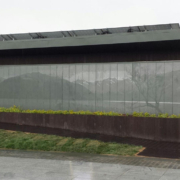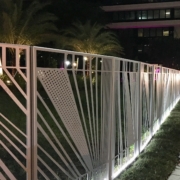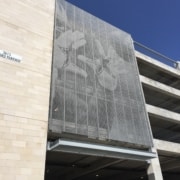The First Memorial To Lynching Victims In The Nation
The Equal Justice Initiative is building a national memorial to victims of lynching in Montgomery, Alabama, which is expected to open in 2018. This memorial project relating to America’s history of racial terror and lynching will become the most ambitious in the nation on this topic. A classical structure was designed for the memorial, consisting of 805 columns – one for each county where EJI documented racial terror lynchings. When visitors enter the memorial, the ground drops and perception shifts as visitors realize that the columns that appeared to be holding up the structure are actually monuments suspended from above, which evoke the lynchings that took place in the public square. Over 4,000 names of lynching victims will be inscribed on these monuments.
In addition to the 805 memorial columns there are 805 identical “memory bank modules” that are temporarily located in the landscape around the memorial and will be relocated to the counties across the country where the lynchings took place. This totals 1,610 modules with over 8,000 names.
We interviewed Eric Simonsen, our VP of Project Management, to discuss this project in more detail.
____________________________________________________________________________________
Product & Materials
Soffit/Ceiling Panels: 20ga elZinc Graphite Flatlock Panels
Custom Fabricated Memorials: 11ga A606 Weathering Steel
Design Challenges
Soffit/Ceiling Panels: “The project presented several ‘design’ challenges. We had to modify our standard flatlock panel system in order to meet the aesthetic, structural, and installation challenges. Aesthetically the design intent was for a completely flat surface. The basis of design was an ‘s-lock’ style panel that would have given the surface alignment of the panels they desired, but it would not have met the structural loading requirements. Our standard flatlock panel has a stepped panel surface where the panels overlap and interlock however it’s the interlocking joints that give the system the strength needed to meet the design loads. So we added a step-down profile to the panel so that they would have a flush surface alignment but maintain the strength we needed. The installation of the panel system is also atypical for our flatlock panel system because it’s being installed over an open grid framing system. Without a solid substrate the attachment points for the panels are limited therefore a great deal of coordination between all trades involved was required throughout the shop drawing process.”
Custom Fabricated Memorials:
“The biggest design challenge for the memorial modules was/and is the handling of data. There are a total of 1,610 unique modules – 805 memorial columns and 805 memory bank modules and there are over 8,000 victim’s names inscribed on those modules. The font selection, font layout and spacing, the fabrication process to inscribe the names, the review process to make sure that the names were accurately transferred from the graphic designer to us for fabrication, and the tracking of all this from design to fabrication completion is a daunting task that we’re proud to be a part of.”
Discuss The Development Process
“The development process for the Custom Fabricated A606 Memorials took many rounds of sample submittals to settle on the exact product and process the designers and client wanted. We experimented with different methods of inscribing the text with etching, fully cut text, text with color inlay, text with contrasting backer, and ultimately settled on fully cut text with the shadow of the interior of the module providing the contrast for legibility. We utilized a variety of different fabrication techniques in order to cut the text and give the designers and clients options on font style as well as font sizing all while analyzing the efficiency of production to maintain the project budget. We also submitted a variety of preweathered finish samples using different preweathering methods to achieve the look desired for the opening of the project while still allowing the metal to weather naturally on-site.”
Custom Fabrication Details
“We’re using a fully automated robotic welding cell to produce the modules. The individual components of each module are laser cut on a CNC laser processing center and the components are then welded together to create the modules using the robotic welding cell. The entire process require a delicate balance between skilled fabricator, programmers, and managers coupled with the advanced technology of the automated production process.”
Comments
“I personally can say that given the current political and sociocultural climate of our country, I’m proud to be part of a project that is working to heal the wounds of our country’s past and working to unify us as people instead of dividing.”







